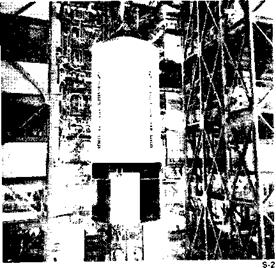SECOND STAGE
SECOND STAGE DESCRIPTION
The second stage of the Saturn V is the most powerful hydrogen-fueled launch vehicle under production. Manufactured and assembled by North American Aviation’s Space Division, it employs the cryogenic (ultra-low temperature) propellants of liquid hydrogen and liquid oxygen, which must be contained at temperatures of -423 and -297 degrees Fahrenheit, respectively.
For the lunar mission, the second stage takes over from the Saturn V’s first stage at an altitude of approximately 200,000 feet (38 miles) and boosts its payload of the third stage and Apollo spacecraft to approximately 606,000 feet (114.5 miles). When its five J-2 engines ignite, the stage is pushing more than one million pounds, a load greater than that of any U. S. booster prior to the Saturn program. Speed of the stage ranges from 6,000 miles per hour to 15,300 miles per hour.
The beginning of second stage boost is a two-step process. Wien all the F-l engines of the first stage have cut off, the first stage separates. Eight ullage rocket motors located around the bottom of the second stage then fire for approximately 4 seconds to give positive acceleration to the stage prior to ignition of the five J-2 engines. About 30 seconds after the first stage separation, the part of the second stage structure on which the ullage rockets
|
|
Mating—A completed second stage is mated to a first stage at Kennedy Space Center, Fla. This particular stage was used for facilities checkout.
are located (the aft interstage) is separated by firing explosive charges. This second separation is a precise maneuver: the 18-foot-high interstage must slip past the engines without touching them. With the stage traveling at great speed, the interstage must clear the engines by only a little more than 3 feet.
The second stage burns for about 6 minutes, pushing its payload into space. At the end of boost, all J-2 engines cut off at once, the stages separate, and the J-2 engine on the third stage begins firing to take it and the Apollo spacecraft into a parking earth orbit. The 81-foot 7-inch second stage is basically a container for its 942,000 pounds of propellant with engines attached at the bottom. Propellants represent more than 90 per cent of the stage’s total weight. Despite this great weight of propellant and the stresses the stage must take during launch and boost, the stage is primarily without an internal framework. It is constructed mostly of lightweight aluminum alloys ribbed in such a fashion that it is rigid enough to withstand the pressures to which it is subjected. Special lightweight insulation had to be developed to kc p its cryogenic propellants from warming and thus turning to gas and becoming totally useless as propellant. The insulation that helps maintain a difference of about 500 degrees between outside (70 to 80-degree normal Florida temperature) and inside (-423° F of liquid hydrogen) is only about 1-1/2 inches thick around the hydrogen tank.
A unique feature of the second stage is its common bulkhead, a single structure which is both the top of the liquid oxygen tank and the bottom of the liquid hydrogen tank. This bulkhead was a critical item in the development of the stage. The relatively thin bulkhead, consisting of two aluminum facing sheets separated by a phenolic honeycomb core insulation, must maintain a temperature difference of 126 degrees between the two sides. The insulation which accomplishes this varies from one-tenth of an inch thickness at the girth to 4-3/4 inches thickness at the apex of the bulkhead. Development of the common bulkhead resulted in a weight saving of appox – imately 4 tons and more than 10 feet in stage length.











